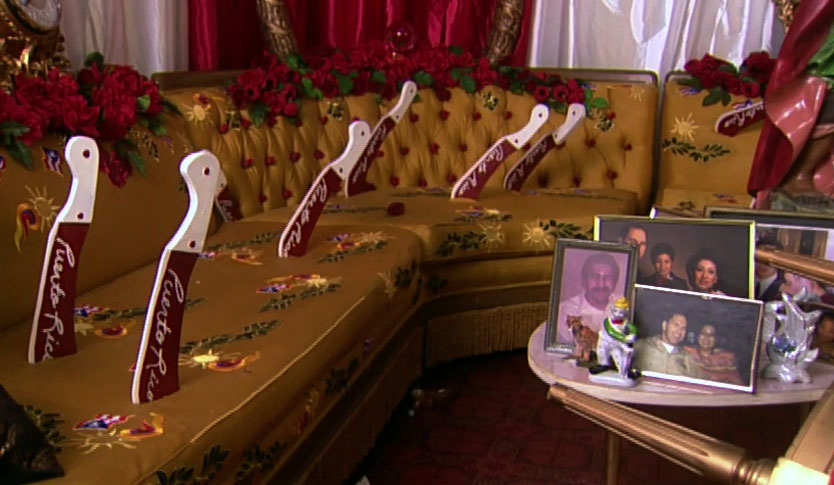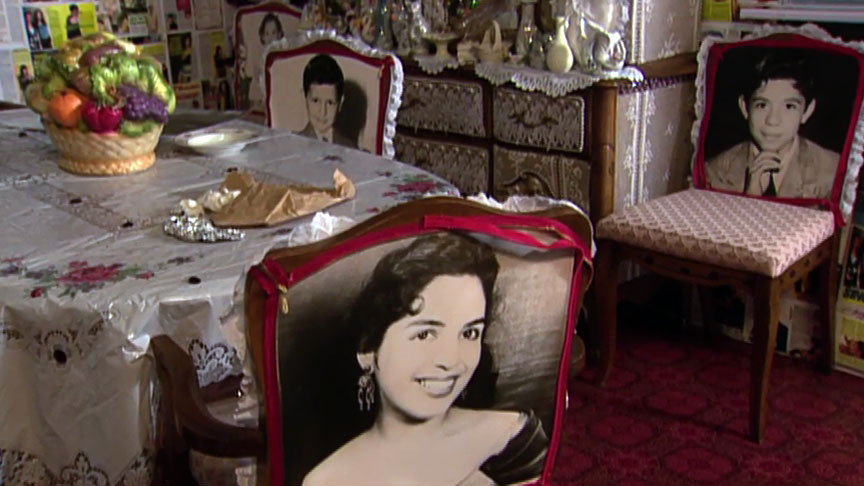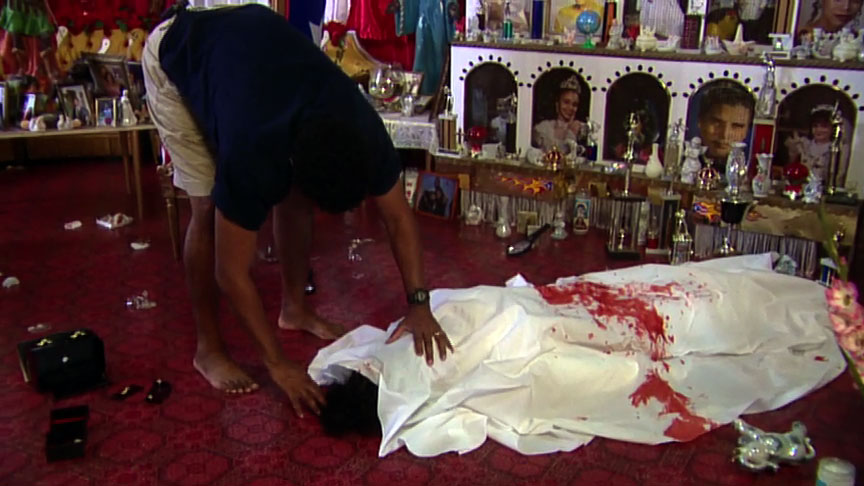Interview
“Scene of the Crime (Whose Crime?)”

Installation view of Scene of the Crime (Whose Crime?) (2003) at Museo de Arte Contemporáneo de Puerto Rico, San Juan, 2000. Production still from the Art in the Twenty-First Century Season 1 episode, Place. © Art21, Inc. 2001.
In this interview, Pepón Osorio talks about his 2003 installation piece, Scene of the Crime (Whose Crime?), which the artist is shown installing at Museo de Arte Contemporáneo de Puerto Rico in Season 1 of Art in the Twenty-First Century.
ART21: How does the size of the installation and the location effect the work?
OSORIO: In my work, I don’t think that there’s one place; I think there are many places. I often feel that the work comes from many different perspectives and different angles, different realities. And I guess—because of the complexity, because of the exuberance, because of the multiplication—the work offers the opportunity for it to happen in more than one place. What I am trying to do specifically with my work—or what I was trying to do at the very beginning with the work, in terms of size—was, in my own terms in the ’80s, a very subversive kind of philosophy. And since I had gone into isolation in the South Bronx, and I was creating work on my own and presenting it in the context of community, then I needed to have an open space, a larger space where the work can be seen. And then in itself, when people came to look at the work, it became greater than their size. So therefore, it demanded attention, and therefore they had to deal with the issue.
When it went to the museum, the work also demanded the same size, and it demanded the same attention. And I think that somehow, subversively, I was thinking not in terms of a museum as much as in terms of storefronts and places where it had to be seen before. And it was quite interesting because, unlike the tradition of artists of color at that time—not finding its place in a museum—I was then demanding the largest place than ever. And for me, that was my connection to the space. I came in as a squatter, more than anything else, into the museum world. And my interventions were pretty much the same way, in storefronts.
Space, for me—it’s not connected. I think that, when I go in into the space, it provides its own spirituality. And so then, for me, my interventions with the work, the work itself—how can I explain it? It’s more like a metaphor than anything else. The space in itself has a spiritual content. My work has its own, and when it comes in, it just comes together in one place. It’s kind of hard to explain because often, in terms of space, I go in with one monumental chunk from any specific community and put it into another place that it does not necessarily fit in. But it’s part of it.
For example, when this piece, Scene of the Crime, was at the Whitney Museum, it almost felt as if I had taken a piece of the South Bronx out of its roots and placed it in the middle of Madison Avenue, you know? And that’s my relation to space. That’s my relation—one of intervening, of intervention—one of somehow juxtaposition, but at the same time trying to fit in or force it into a location, more than anything else. And maybe that’s how I feel with my work, that it goes against the grain. But somehow, because of its spiritual qualities, it flows in itself.
ART21: What in your work, specifically, do you think goes against the grain?
OSORIO: Against the grains of the aesthetics of the art canons. I’m very much aware that my work is one that provides, aesthetically, an uncomfortable reaction in many people. But I think I also feel that it provides the right challenges at the right time and at the right moment. And I’m very comfortable with that and very conscious. It’s interesting because a lot of people ask me, “Do you live like this? Is this how your home is?” And it isn’t. I am making a very calculated intervention. Not that I dislike what I do, but I’m very much aware of what I’m doing. And I’m very much aware that what I wanted to do is to provoke change, not only socially but also physically and spiritually.

Installation view of Scene of the Crime (Whose Crime?) (2003) at Museo de Arte Contemporáneo de Puerto Rico, San Juan, 2000. Production still from the Art in the Twenty-First Century Season 1 episode, Place. © Art21, Inc. 2001.
ART21: And provoking change, in all these aspects, is what an artist does?
OSORIO: Yeah, in Scene of the Crime, I borrow from the past to deal with the present, and present tense. I take into consideration a lot of the formal issues in the arts and apply them to it, to my work. If we look at the sense of color—color is pretty much in it. I think that form, also, is very much a concern of mine. But I also feel that, in a lot of the work that I do, somehow I have resolved that aspect of the work. And there are other aspects that I feel that I am more inclined to explore, which are the social, the more ethical and sociological.
I often feel that I make a lot of new discoveries as I go along, creating work. And in Scene of the Crime my greatest discovery was the connection to color, my connection to the light, in that sense. And those explorations happen at one level. And then on the other level, my mind is working differently: How do I combine all these connections that I think that we all have and bring it in a more popular sense, in a democratic way that everyone can relate to it, in a certain, same level? And I think that, somehow, my work also deals with that. It is simple enough to people who make an immediate connection, and it is complicated enough for the intellectuals who are interested in looking at the work in a more academic way.
And I think that, somehow, there is a connection to both places, because it’s exactly where I am; I am in both places. I deal with the academic. All of a sudden, I turn around and I go into these places that are very forbidden places. And I’m there, and I’m working, and then I go back. I could be in 77 Madison Avenue; then I go to—I don’t know—Longwood Avenue, to my studio, and then I work. And then all of a sudden, I’m out of there and I go to another place, and I’m somewhere in different locations in one day. And I think that that’s the richness of the work, because those three different realities I bring in immediately as I create unconsciously. That, for me, is more important than the formal issues in themselves and somehow I guess because I have taken it for granted.

Pepón Osorio installs Scene of the Crime (Whose Crime?) (2003) at Museo de Arte Contemporáneo de Puerto Rico, San Juan, 2000. Production still from the Art in the Twenty-First Century Season 1 episode, Place. © Art21, Inc. 2001.
In Scene of the Crime, the living room is red. It relates to passion. It relates also to the scene, to the crime scene, to the color red—that is so much associated with anger, that is so much associated with crime, that is so much associated with passion. And then the dining room—it’s white, which is so much associated with richness and a more contemplated space. And I’m trying to bring together, in that sense, in Scene of the Crime, a place that is for meditation as much as a place that is for anger. And there is a place for all of it within one, creating a harmonious balance in between. And all this, as I said, is very calculated. I’m very much aware of it, but I just don’t get stuck there. I move forward, because I think that the greater discoveries are the ones that we think the formal issues provide you. Those are the challenges—those opportunities that you have to grab and move on. If I’m stuck there, then I just do art for art’s sake, and I’m not trying to do that.



